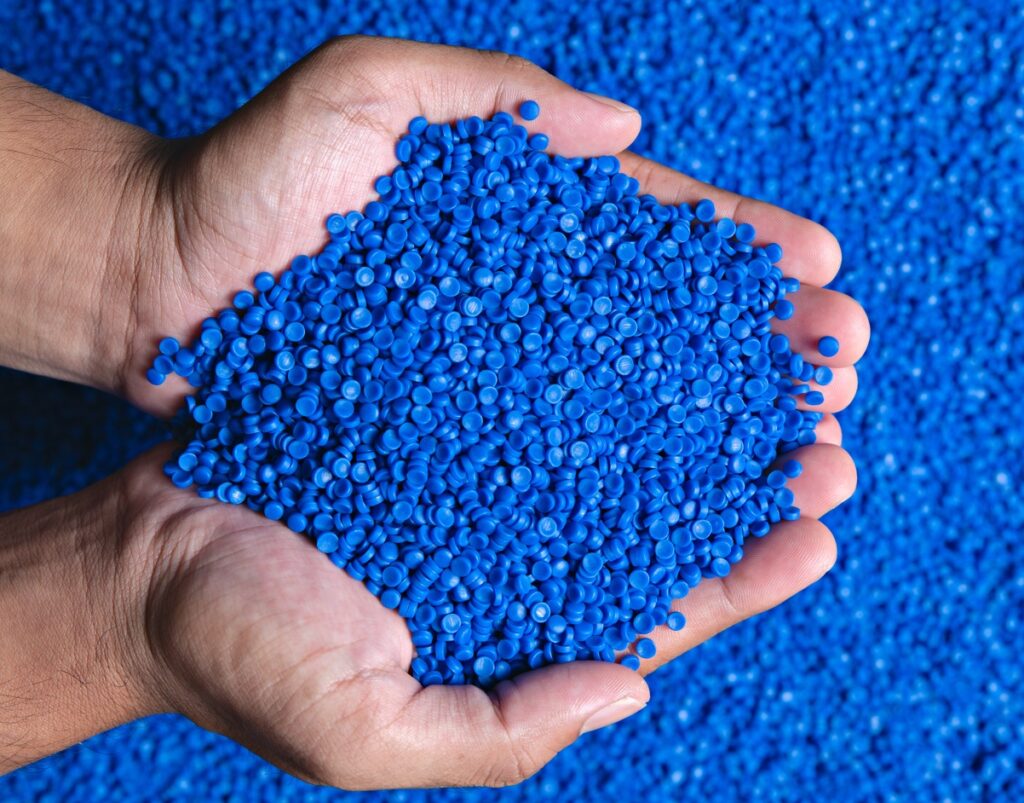There are over 60,000 different grades of plastics and growing each year. If you are developing a product that requires selection of a plastic, it can be quite a daunting task to determine the best plastic for your application among so many choices. This article shares the methods we use to help our clients with injection molding material selection.
Searching an Online Injection Molding Material Database
There are a few online material databases but the one that we use most often is a well-organized site called Matweb.com which details the properties of many materials including plastics, metals, ceramics, etc. While the website does have some functionality without a subscription, you’ll find that it’s worthwhile to purchase an annual subscription which provides two key benefits: 1) The subscription allows you to search for materials that meet the material properties you specify. For example, you may want to find a grade of polycarbonate that has high transparency, a polypropylene with high stiffness or all material types that are in the range of tensile modulus that you need for your application.
Matweb provides a list of all materials that meet your specifications. 2) The subscription also provides a very useful tool that simplifies the step of entering material data into Solidworks. Once you’ve identified the material you want to specify you can download the material properties directly into Solidworks and immediately begin performing finite elements analysis. This feature saves a lot of time and avoids typos that can throw off your analysis.
When You Need to Make a Decision on Your Injection Molding Material Selection
Clients commonly ask us, when is the appropriate time during development to select a material? It may seem intuitive that the material needs to be selected before starting prototype tooling as the mold design requires that the material be defined so the appropriate shrinkage may be applied to the mold design. However, we contend that while this is the “deadline” for material selection, the best time to define the material is after concept selection when the part is to be designed. Part design requires consideration of forces applied, tolerances, environment of use/storage, etc.
Many of these design considerations will drive part geometry that is dependent on the material selected. For example, wall thickness will vary in a part that has a large force applied whether the material selected is relatively strong such as polycarbonate vs a weaker material such as polypropylene. The polypropylene part would require a thicker wall and perhaps support features such as gussets to support a large load that a polycarbonate part could support in a thinner wall.
Therefore, it is better practice to select your materials before starting detailed part design rather than waiting for prototype molding.

Understanding How Plastics are Organized
When selecting a plastic for your application, it’s important to recognize that materials are organized first into types, then into sub-types, specialty grades and finally by manufacturer. At the highest level are the types. Examples of types are ABS, polycarbonate, polypropylene, acrylic, thermoplastic elastomer (TPE), etc. Within each type are the sub-types. For example, under the type polypropylene there are sub-types such as Random Copolymer, Homopolymer, etc.
Then there are the specialty grades for unique functions such as high impact, clarity, anti-static, additives, etc. Then you’ll also find that several different manufacturers will offer the same grade of material. It’s always best to select a material that is available from multiple manufacturers whenever possible. Selecting a material available from multiple manufacturers lowers the risk of the material being discontinued (which happens more often than you would expect) and competition between manufacturers lowers costs in manufacturing.
Each Material Meets a Unique Need for Injection Molding Projects
About now you’re probably wondering how we can possibly select a material among tens of thousands of possibilities. The key is to know that each material type has a set of unique traits. Each material type isn’t intended to be used in a wide variety of applications. Each material type is intended by the material manufacturer to address a certain set of product requirements through its unique traits such that it fits a certain niche. Material types may overlap in some product requirements but in general each material type fills a unique need.
For example, if the part requires fluid storage and tight tolerances are not critical then the part would be a good candidate for polypropylene. Polypropylene’s traits are that it has very good moisture vapor transmission performance but poor dimensional stability.
Therefore, it’s very important for the engineer that designs plastic products to know what the unique traits are for each material type and subtype. It requires extensive experience and reading trade magazines to keep up to date on new materials. Plastics is an area of extensive research and development as manufacturers continue to push the limits of plastics as lower cost alternatives to other materials such as metals.
Consideration for Selecting a Specific Material Grade
Once we assist the client to select the type and subtype, we then recommend the specific material grade. Here are some of the application specific considerations we discuss with clients when selecting a material grade:
- Aesthetic requirements such as transparency, gloss, etc.
- Mechanical requirements. Consider forces, motion, and interactions with other parts that will occur with the application.
- Tolerances. If your part has a need for tight tolerances, then it would be necessary to select a material with low shrinkage and dimensional stability.
- Environment. A part used in certain environments for storage and operation such as chemical, molding temperature, humidity, cycling, etc will also be a factor in the material choice.
- Assembly. Parts to be assembled need to be molded from compatible materials in some assembly methods such as ultrasonic welding, laser welding, adhesive bonding, pad printing, etc.
- Sterilization. Will the product be a single use sterilized disposable sterilized or a sterilized reusable? What is the sterilization method? i.e., gamma, e-beam, EtO and steam.
- Regulatory requirements. Certain industries such as medical, automotive, and aerospace have specific regulatory requirements. For example, medical products have biocompatibility requirements based on the use and duration of contact with the patient.
- Electrical. Certain applications require plastics to function as conductors or insulators. The application can also have heat and flame resistance requirements.
- Cost. When selecting materials, it is critical to consider material cost. Cost must always be considered in context of anticipated annual volume since pricing can vary significantly for plastics vs the purchased annual volume.
- Availability. After you’ve identified a specific grade of plastic for your application, it’s necessary to contact the material distributor to confirm availability. There are some plastics that are only available in certain areas. It can be frustrating to specify a material just to find that it’s only sold in Asia or that it’s often backordered. Availability should always be confirmed before significant development work has been completed.
- Special requirements. There may be other unique functions to consider such as permeability, friction, contact angle, absorption, transparency, moisture vapor transmission rate, leachables, wear resistance, etc.
Depending on the answers to the questions we’ll help the client select the grade within the appropriate type and subtype that meets the unique needs of the product. There will be times when there isn’t an off the shelf product available that meets all requirements. Fortunately, materials may be customized with if the off the shelf material doesn’t quite meet requirements. Additives are available to meet in a wide variety of functions. They can be used to adjust friction, lubrication, contact angle, heat transfer, fragrance, conduction, wear, flame retardants, radiopacity, etc. In addition, there are material compounders that will customize their additives for your specific application.
It can certainly seem like an intimidating task to select the right material for your application among the tens of thousands of plastic grades available. With well-defined product requirements and the help of our experienced engineers, we can help you navigate the material selection process and ensure that your prototype molded parts meet functional requirements the first time.



